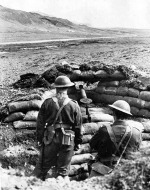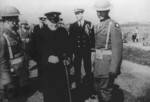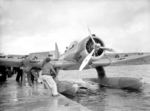
Iceland
| Full Name | 90 Kingdom of Iceland | |
| Alliance | Neutral or Non-Belligerent | |
| Possessing Power | Denmark | |
| Entry into WW2 | 10 May 1940 | |
| Population in 1939 | 120,000 |
Contributor: C. Peter Chen
ww2dbaseIn 1874, Iceland, an island between Greenland, Britain, and Norway, was granted limited home rule by its possessing power, Denmark. In 1918, the Danish-Icelandic Act of Union was signed, establishing Iceland as a fully sovereign state in a personal union with Denmark, and the act was to last for 25 years; it was also agreed that Denmark was to handle foreign policy on behalf of Iceland. When the war in Europe began in 1939, Denmark's declaration of neutrality applied to Iceland as well. On 10 Apr 1940, one day after Denmark became occupied by Germany, the Althing, the Icelandic parliament, passed resolutions granting the Icelandic cabinet full powers, including the power over foreign policy. For the next few weeks, Britain courted Iceland, seeking to bring Iceland into the war on the side of the Allies, but all attempts failed. Fearing a German occupation, British forces invaded Iceland on 10 May 1940. Iceland protested, calling the invasion a "flagrant violation" of the country's neutrality but, Prime Minister Hermann Jónasson also announced over radio that the citizens of Iceland should treat British troops as guests. The invasion of Iceland saw minimal actual fighting; less than ten were killed on both sides. By 1941, about 25,000 British troops were stationed on Iceland. In the same year, the Althing adopted a law creating the position of regent for Sveinn Björnsson. Also in 1941, in Jul, Britain forced Iceland into signing an agreement which allowed American troops to be stationed in Iceland, thus freeing British troops to serve elsewhere; the number of US troops would eventually reach 40,000, which was about a third of the native population. Iceland hosted a number of important airfields for the Allies, as well as being the staging point for many of the Atlantic Convoys bringing war goods to Murmansk and Arkhangelsk in northern Russia. On 17 Jun 1944, after the expiration of the Act of Union of 1918, Iceland declared formal independence as a republic and continued to nominally observe neutrality in the war; Björnsson became the nation's first president. Danish King Christian X, from occupied Denmark, sent a message of congratulations to the Icelandic people. Allied occupation troops did not depart until 1946.
ww2dbaseSource: Wikipedia
Last Major Update: Mar 2013
| Events Taken Place in Iceland | ||
| Invasion and Occupation of Iceland | 10 May 1940 - 31 Dec 1945 | |
| Arctic Convoys | 21 Aug 1941 - 30 May 1945 | |
Weather
WW2-Era Weather Data for Iceland
Photographs
 |  |  |  |
Iceland in World War II Interactive Map
Please consider supporting us on Patreon. Even $1 per month will go a long way! Thank you. Please help us spread the word: Stay updated with WW2DB: |
Visitor Submitted Comments
All visitor submitted comments are opinions of those making the submissions and do not reflect views of WW2DB.

- » Wreck of Teruzuki Found (27 Jul 2025)
- » USS Orlean's Bow Found (22 Jul 2025)
- » The Emperor of Japan Planned to Honor WW2-era Japanese POWs in Mongolia (4 Jul 2025)
- » US State Lawmaker John Winter Caught Using Racial Slur "Jap" and Apologized (11 Jun 2025)
- » US Government Plans to Purge WW2 Information (17 Mar 2025)
- » See all news
- » 1,182 biographies
- » 337 events
- » 45,119 timeline entries
- » 1,248 ships
- » 350 aircraft models
- » 207 vehicle models
- » 376 weapon models
- » 123 historical documents
- » 261 facilities
- » 470 book reviews
- » 28,410 photos
- » 365 maps
Winston Churchill
Please consider supporting us on Patreon. Even $1 a month will go a long way. Thank you!
Or, please support us by purchasing some WW2DB merchandise at TeeSpring, Thank you!
11 Jul 2018 04:46:38 PM
my uncle was with the US Army, and died in a plane crash in Iceland on January 18, 1945 on his way home near the end of the war. I am visiting Iceland on August 8 through 16 and I am looking for information on that crash. Thank you.